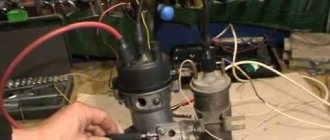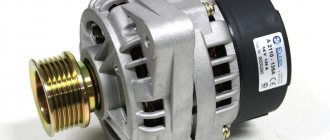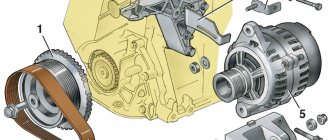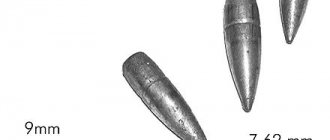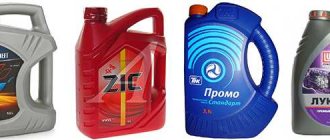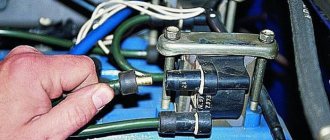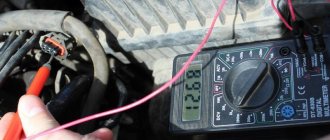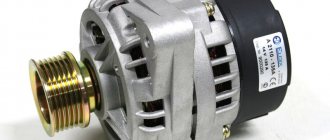Installing gas equipment (LPG) reduces fuel costs, but seriously changes the operating mode of the engine. Many drivers who have installed gas equipment in their car are wondering whether they need any special spark plugs for gas, and if so, which ones?
After reading the article, you will learn how and why the operating mode of the engine changes, what processes occur in the combustion chamber and how spark plugs affect them. This will help you choose spark plugs that will make the engine work better and will not reduce its service life.
What happens in the cylinders
The car's power unit operates on an air-fuel mixture, in which the fuel-to-air ratio ranges from 1:13 to 1:20. To give the car strong acceleration, you have to over-enrich the mixture.
During uniform movement in a straight line, the engine runs at the leanest possible mixture. These operations are performed by an injector or carburetor. Changing the fuel/air ratio changes the main characteristics of the mixture:
- spark sensitivity;
- tendency to detonation;
- combustion speed and temperature;
- amount of exhaust gases.
The rate of fuel combustion, as well as the amount of energy released, is affected by:
- compression;
- composition of the air-fuel mixture;
- engine temperature;
- operating mode of the power unit;
- ignition voltage;
- ignition timing angle (IDA);
- gap between spark plug electrodes;
- glow number of the candle.
How fuel burns
Fuel combustion occurs differently in a cold engine than in a hot one. The fuel-air mixture in a cold power unit flares up slowly, so it is necessary to re-enrich it, because the ignition spark that breaks the gap between the electrodes turns out to be too weak.
Even the injector cannot properly atomize fuel in a cold combustion chamber, so part of the fuel settles on the walls of the piston and cylinders. Therefore, in cold engine mode, much depends on the intensity of the spark, which is determined by the voltage, the shape of the electrodes and the gap.
The constant presence of the spark plug in the high temperature zone leads to such heating of the electrodes that it causes glow ignition. In this case, the mixture ignites not from a spark that breaks the gap between the electrodes, but from contact with a hot spark plug.
What is the difference between gasoline and gas
Here are the main differences between gasoline and liquefied natural gas (LNG):
- octane number: gasoline 95–98, gas 105–115;
- boiling point: gasoline from 33 degrees, LNG minus 42 degrees;
- engine compression ratio: gasoline 9.0–10.0 gas 10.5–12.
The characteristics of gas (propane and butane) are very different from gasoline. A high octane number does not allow you to simply connect an LPG to an engine designed to work with 80 or 92 gasoline, because such fuel will quickly damage the engine.
If the compression ratio is greatly mismatched with the fuel, the temperature and combustion rate of the fuel will change. In addition, the injector sprays propane more efficiently than gasoline. A high octane number requires an increase in the compression ratio to at least 10.5, otherwise the engine will overheat in high power mode.
When operating on LNG, carbon deposits do not form on valves and spark plugs, even if the compression ratio is insufficient, which is a serious advantage of gas.
There is a known case when an LPG (propane) injector was connected to a working Gazelle with a ZMZ 406 engine without even adjusting the ignition. After 40 thousand kilometers, one of the cylinder head valves burned out due to severe overheating.
There is also a known case when a rebuilt carburetor ZMZ-402 under 92 (and not an injector, but a carburetor), installed on an old Volga, ran on gas for 250 thousand kilometers until the next repair. Because the driver was attentive to the preparation of the engine.
I increased the compression ratio by grinding the cylinder head, set the correct ignition and installed the coldest spark plugs.
Do you need special spark plugs for LNG?
If you are going to drive fast, but the engine compression ratio is below 11, then you need to install the coldest available spark plugs. It is advisable to select a heat rating of at least 23 and check the gap and carbon deposits every 2-3 thousand kilometers.
If you have completely switched to CNG and are not going to drive on gasoline, then soot does not appear on the spark plug, and the slightly changed gap between the electrodes does not threaten the engine. If an engine with a compression ratio of over 9.5 constantly runs on CNG, then most of the problems that await engines that consume gasoline and gas do not arise. After all, a spark plug that is too cold is covered with soot, and a spark plug that is too hot will change the gap depending on the temperature. All this negatively affects the operation of the engine.
If you care about your gasoline engine and decide to convert it to gas/petrol, take it to a grinder to have it sand the cylinder head to increase the compression ratio, and then adjust the cylinder head. In this case, installing cold candles will give maximum effect. If this is not done, then no special spark plugs for gas will be able to preserve the life of the engine.
Conclusion
Now you know which type of spark plugs is best suited for gas, and you are also familiar with the measures that will extend the life of the engine. By following the recommendations in this article, you will avoid reducing the service life of the engine and extend its mileage.
Spark plugs for HBO
Car owners are increasingly switching their cars to gas. This is due to the fact that the usual gasoline is becoming more and more expensive. Gas, on average, is about 30-40% cheaper than gasoline. Depending on the operating conditions and the volume of fuel consumed, the installation of gas equipment pays for itself in a period of 6 months to several years.
However, in addition to installing a cylinder, gearbox, lines, injectors and other equipment in the car, you need to prepare the engine itself for the new fuel, first of all, choose the right spark plugs for gas in a car with LPG.
It would seem that such a simple component of the ignition system should not have much impact on operation or create problems. On the contrary, choosing the right spark plugs for LPG is very important, both for fuel economy and for overall ride quality. First, we will talk about which spark plugs are best for 4th generation LPG, and then we will explain their differences from conventional ones.
What candles for HBO should I buy?
Let's see which gas candles are popular. The review included 6 options, the price of the most expensive differs from the most budget-friendly by more than ten times, and they are sorted in descending order. The approximate cost of the kit for a 4-cylinder engine is given.
- NGK Laser Line 2 are the most expensive units in this review, they have an iridium electrode and platinum surfacing on the side electrode. They work very well and are durable. Sparking is stable, regardless of speed. Their price, about 4,000 rubles, is due to both the use of expensive metals and the popularity of the brand. With them, noticeable, about 5-8%, fuel savings and an increase in power are achieved - up to 2% on gas. They also work well on gasoline.
- Denso IW20 is a Japanese product; its feature is a very thin central electrode, about 0.4 mm, versus 2.5 mm for competitors. The thin electrode provides a high-quality and powerful spark that ignites both gasoline and gas perfectly. The refractoriness of the electrodes gives an excellent resource; the price tag is 2500 rubles, although almost half as much as the previous ones, but you can’t call it budget.
- Bosch WR7DP are quite unusual. The Bosch company, which makes popular ignition systems, by the way, has made an unusual move that protects the electrode from contamination. The central electrode is recessed as much as possible into the insulator, which provides a kind of protection against deposits. Power and consumption figures are slightly worse than those of more expensive competitors, but the WR7DP are good spark plugs for gasoline and gas. The price is already more pleasant for the consumer - 1000 rubles, with good quality.
- Brisk. LR15YS Polish spark plugs for gas engines, intended for gas engines, the central electrode is thinner than that of gasoline ones, but thicker than that of iridium ones, and it is also coated with silver. In terms of quality, they occupy a middle position between gasoline and the first three points of our review. Their price is very pleasant - 500 rubles. per set.
- Beru 14R-7DU do not have any marks from the manufacturer stating that these are spark plugs for propane and gasoline gas, but they work quite well on gas. Otherwise, the quality is at the Brisk level, as is the price - 400 rubles.
- Plazmo for Super GAZ is the cheapest option for gas, produced in Ukraine, there are no special differences in operation from the previous version. The quality for their price (250 rubles) is very good, judging by the reviews of car owners, they can withstand long-term use (about 100,000 km), and the price allows them to be changed more often.
How to choose spark plugs for an engine with LPG?
Once you have installed HBO on your car and felt real savings and moral satisfaction, your driving will become carefree. However, it must be remembered that LPG, like any equipment, requires regular maintenance and knowledge of certain subtleties, without which operating a car on gas will be impossible.
Today we will talk about how to approach the choice of spark plugs for gas equipment, as well as how they differ from ordinary spark plugs. You can, of course, install ordinary spark plugs (gasoline), which will most likely allow you to operate your car, but your engine with LPG is unlikely to be able to reach its full potential with such spark plugs. You can trust the specialists of the service where you are served and buy candles for LPG that they recommend.
However, with this approach, you can easily become a victim of interested parties who, under the guise of good candles, will sell you those that are profitable for them to sell to you. In other words, trust but verify.
To begin with, about the glow ignition of spark plugs
I will say right away that it is customary to characterize the thermal characteristics of a candle using this value. Glow ignition, to put it in simple language, is the temperature at which ignition of the fuel mixture will occur not from a spark, but from a heated electrode.
Gas, unlike gasoline, ignites slightly differently, and the combustion rate of gas is several times lower, so the gas mixture will be leaner than gasoline. When the engine runs on gas, the fuel-air mixture needs a higher voltage in order to ignite - 16 kV compared to gasoline, for which this value is 14 kV.
When a gas mixture is burned, the temperature in the combustion chamber is much higher, as a result of which conventional gasoline spark plugs wear out much faster. It is for this reason that spark plugs on HBO must be installed “cold”, that is, with a higher heat rating.
Iridium spark plugs for gas equipment
According to some experts and understanding people, it is better to install iridium spark plugs equipment, since in their production, or more precisely in the production of the central electrode, ordinary steel is replaced by iridium or platinum.
Increased distance between electrodes
The danger here lies in the possible breakdown of the spark plug insulator or even the ignition coil; the consequences of this are very unpleasant and costly. This occurs because current follows the path of least resistance.
Even if a breakdown does not occur, then, most likely, the increased gap will not provide the opportunity for the formation of a current arc, the so-called spark. The absence of a spark will lead to the fact that the working mixture in the cylinder will not ignite and, accordingly, this cylinder will not work. In such cases, they say that the engine is “troubling”, that is, 3 out of 4 cylinders are working. Also a sign of a larger gap than required is popping noises coming from the exhaust system.
An increase in the gap should not be attributed to any malfunction - this is a completely natural process that occurs over time, as the electrodes gradually burn out. Therefore, it is advisable to check the spark plugs during maintenance (after 10,000–15,000 km) and, if necessary, make adjustments, although the official dealer most likely will not “bother” with this topic and will simply offer a replacement.
Spark plugs for gas, what should be the gap, do they need to be changed
LPG equipment really solves the issue of saving fuel and raises the level of environmental friendliness of a car to the level of European standards. This conclusion was reached by the majority of drivers of cars converted to gas. Recently, alternative fuels have also been installed in diesel cars; they were once considered economical.
Converting a car to LPG involves replacing spark plugs and engine oil. Why do this, and what are the best gas spark plugs?
Why do they change spark plugs when installing LPG?
When the HBO kit is installed by professionals, they warn the car owner about the need to change the spark plugs. They are different from the petrol version. Re-equipping a car changes the performance characteristics of the engine.
What is the difference? Gasoline spark plugs are designed to ignite a gasoline-air mixture with a certain combustion temperature. The gas-air mixture is not so dense, has greater electrical resistance and heat at the moment of ignition. The interelectrode gap of gas spark plugs is reduced in comparison with similar gasoline spark plugs.
At elevated temperatures, they must have an increased degree of resistance to heat. Intense heating of the electrodes provokes glow ignition. In fact, ignition does not come from sparks breaking the gap between the electrodes, but from contact with hot candles.
For carburetor and injection vehicles with light loads, spark plugs with a low heat rating are recommended. Such devices immediately warm up to the required temperature of 700–800 C and ignite the air-fuel mixture well in a cold internal combustion engine.
When the heat number is much higher, the candles do not have time to warm up to the required temperatures. Gradually, carbon deposits form on them. The period of use is much shorter.
Engine power suffers because the combustion mode of the gas-air mixture in the cylinders is disrupted. On a note! For high-temperature internal combustion engines with a heavy load, installing a spark plug with a higher heat rating is justified.
How to choose candles?
Since a “cold” candle works at high temperatures, and a “hot” one at lower temperatures, spark plugs for HBO need “cold” ones. Manufacturers do not write the brand, car model or fuel type on their products. They indicate the heat number.
“Hot” (according to the Russian standard) have a heat rating from 11 to 14, medium from 17 to 19, cold from 20 or more. Well-known foreign manufacturers may have different numbers. So, for example, cold spark plugs bosch and beru have numbers 5 and 6, brisk - 14, denso - 22.
You should know the differences between gas spark plugs and gasoline spark plugs:
- The spark plug gap is smaller on gas. Because of this, the air-fuel mixture ignites no less efficiently than the air-gasoline mixture.
- The lpg spark plugs have a high heat rating and can withstand heat loads well.
- Universal spark plugs for gas and gasoline, high quality, not cheap, will help increase the power of the internal combustion engine.
- The use of high-quality products is a guarantee of fuel savings. Cheap options will not give much effect.
Good spark plugs for gas have a high price due to the use of the following metals in their manufacturing technology:
- iridium. The central electrode is made from it;
- the side electrodes are covered with a platinum layer;
- improve performance characteristics such as heat dissipation by copper rods.
On a note! Sometimes manufacturing plants change the design of devices for cng and lpg, equipping the cases with a second layer. When working on propane or methane, spark plug carbon does not appear as quickly.
Advantages of spark plugs with iridium
Denso iridium spark plugs are ten times more expensive than simple spark plugs for 4th generation HBO. They have a long service life due to the aluminum oxide insulator and the use of gas-tight central electrode insulators. The use of precious metals extends the life of the product.
How do gas kits differ from petrol kits?
The heat rating is a characteristic that describes how much heat the spark plug transfers to the engine head. According to the heat number, they are distinguished:
- cold (c. h. 20+);
- average (part 14-19);
- hot (parts 11-14).
The heat number of spark plugs for HBO should be colder (higher) than for gasoline.
The gap between the electrodes is very important: if it is too large, too much stress will be placed on the ignition coil. More voltage will be required for spark breakdown. If it is too small, the spark will be weak. The gas-air mixture has greater electrical resistance than the mixture of gasoline and air. To stop this difference, reduce the gap between the side and central electrodes. The gap on the spark plugs on the HBO is about 0.8 mm.
If you drive gasoline spark plugs using LPG, soot and unnecessary deposits will form on them; their overheating will lead to premature failure or glow ignition. In addition, carbon deposits will be stronger both on the cylinder and in the exhaust system. It is better to drive gas cars with gasoline as fuel than vice versa.

